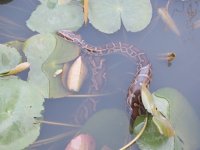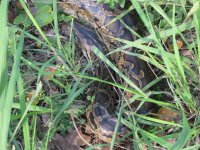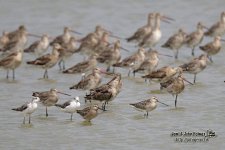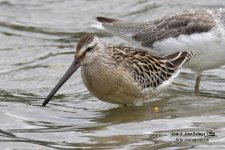johnallcock
Well-known member
I haven't got around to posting any updates for a while. This has been largely due to work - one week out of the office for a workshop about shorebird conservation and just really busy apart from that. I have managed to find time to get out birding, but for the most part have not succeeded to find much of interest. Duck numbers have continued to be good, though, including a Baer's Pochard for the third successive winter (I think one of the birds from last year). Possibly because of all the ducks, the eagles (Imperial and Greater Spotted) have been putting on a good show.
We had a very cold, wet period at the start of this week, which I was hoping would bring some birds. In fact, the only bird of note I have seen following this was a Red-breasted Flycatcher. There was also a Spoon-billed Sandpiper seen along the Access Road into the reserve at the start of the week, but I missed it.
I have been trying to get out to look for shorebirds on the high tide all week but haven't had the chance. So, although I wasn't working today, I decided to give the tide a try. In fact, it did not rise as high as predicted and the birds were fairly distant. Highlights were the large gulls - a good number of Heuglin's with a few Caspian, 3 Black-tailed and a Slaty-backed.
While heading around the reserve towards the hides, I had stopped to check out the Tufted Ducks. Hearing a strange call I looked up and noticed that the 'cormorant' flying over was actually orange, with a pale head and white underwing - a Ruddy Shelduck (#267). This dropped down onto the main scrape, landing among the ducks at the far end from me. This is the first record for a few years so I was really pleased with the sighting. Unfortunately it seems not to have stayed and I'm not sure that many others saw the bird. And then, just as I was heading out of the reserve in the afternoon a Russet Bush Warbler (#268) started singing just 20m or so from the exit. A great way to end the day and a reminder that the year list is not over yet!
We had a very cold, wet period at the start of this week, which I was hoping would bring some birds. In fact, the only bird of note I have seen following this was a Red-breasted Flycatcher. There was also a Spoon-billed Sandpiper seen along the Access Road into the reserve at the start of the week, but I missed it.
I have been trying to get out to look for shorebirds on the high tide all week but haven't had the chance. So, although I wasn't working today, I decided to give the tide a try. In fact, it did not rise as high as predicted and the birds were fairly distant. Highlights were the large gulls - a good number of Heuglin's with a few Caspian, 3 Black-tailed and a Slaty-backed.
While heading around the reserve towards the hides, I had stopped to check out the Tufted Ducks. Hearing a strange call I looked up and noticed that the 'cormorant' flying over was actually orange, with a pale head and white underwing - a Ruddy Shelduck (#267). This dropped down onto the main scrape, landing among the ducks at the far end from me. This is the first record for a few years so I was really pleased with the sighting. Unfortunately it seems not to have stayed and I'm not sure that many others saw the bird. And then, just as I was heading out of the reserve in the afternoon a Russet Bush Warbler (#268) started singing just 20m or so from the exit. A great way to end the day and a reminder that the year list is not over yet!










